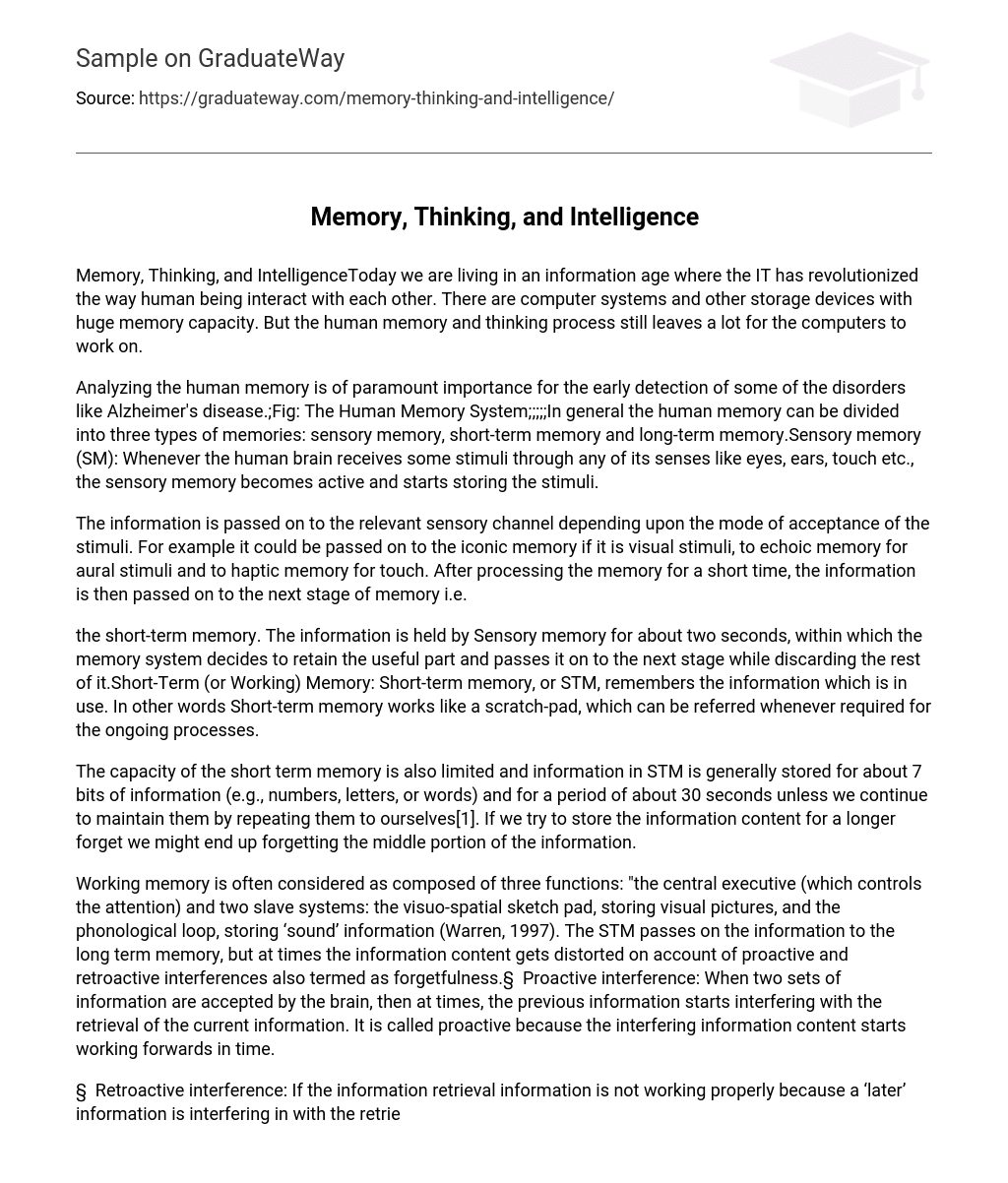Memory, Thinking, and IntelligenceToday we are living in an information age where the IT has revolutionized the way human being interact with each other. There are computer systems and other storage devices with huge memory capacity. But the human memory and thinking process still leaves a lot for the computers to work on.
Analyzing the human memory is of paramount importance for the early detection of some of the disorders like Alzheimer’s disease.;Fig: The Human Memory System;;;;;In general the human memory can be divided into three types of memories: sensory memory, short-term memory and long-term memory.Sensory memory (SM): Whenever the human brain receives some stimuli through any of its senses like eyes, ears, touch etc., the sensory memory becomes active and starts storing the stimuli.
The information is passed on to the relevant sensory channel depending upon the mode of acceptance of the stimuli. For example it could be passed on to the iconic memory if it is visual stimuli, to echoic memory for aural stimuli and to haptic memory for touch. After processing the memory for a short time, the information is then passed on to the next stage of memory i.e.
the short-term memory. The information is held by Sensory memory for about two seconds, within which the memory system decides to retain the useful part and passes it on to the next stage while discarding the rest of it.Short-Term (or Working) Memory: Short-term memory, or STM, remembers the information which is in use. In other words Short-term memory works like a scratch-pad, which can be referred whenever required for the ongoing processes.
The capacity of the short term memory is also limited and information in STM is generally stored for about 7 bits of information (e.g., numbers, letters, or words) and for a period of about 30 seconds unless we continue to maintain them by repeating them to ourselves[1]. If we try to store the information content for a longer forget we might end up forgetting the middle portion of the information.
Working memory is often considered as composed of three functions: “the central executive (which controls the attention) and two slave systems: the visuo-spatial sketch pad, storing visual pictures, and the phonological loop, storing ‘sound’ information (Warren, 1997). The STM passes on the information to the long term memory, but at times the information content gets distorted on account of proactive and retroactive interferences also termed as forgetfulness.§ Proactive interference: When two sets of information are accepted by the brain, then at times, the previous information starts interfering with the retrieval of the current information. It is called proactive because the interfering information content starts working forwards in time.
§ Retroactive interference: If the information retrieval information is not working properly because a ‘later’ information is interfering in with the retrieval of a former information, then it is called retroactive interference. It is called retroactive, as the interfering information is working backwards in time. Long-term Memory (LTM): The information is passed on to the Long term memory by the STM if the information is considered fit enough for longer duration storage. This helps in longer duration stay of the information content.
The long term memory itself is divided into two types depending upon the type of information content. The ‘episodic memory’ helps in remembering the events and experiences in a chronological order while the ‘semantic memory’ is the database of the training that we received, facts we learned, concepts or skill that we picked up. The episodic memory helps in reconstructing the entire episode of events that took place before us while semantic memory also get assistance from episodic memory in recalling the facts and figures. The three main stages of Long term memory are; storage, deletion and retrieval.
References:1. Human Memory. Available online at http://www.cc.
gatech.edu/classes/cs6751_97_winter/Topics/human-cap/memory.html (Jan 5, 2008)2. The human memory system.
Available online at http://www.uni.edu/walsh/applebymc.html (Jan 5, 2008)3.
Warren , Suzanne (1997). Remember This: Memory and the Brain. Available online at http://serendip.brynmawr.edu/biology/b103/f97/projects97/Warren.html (Jan 5, 2008)[1] http://www.uni.edu/walsh/applebymc.html





